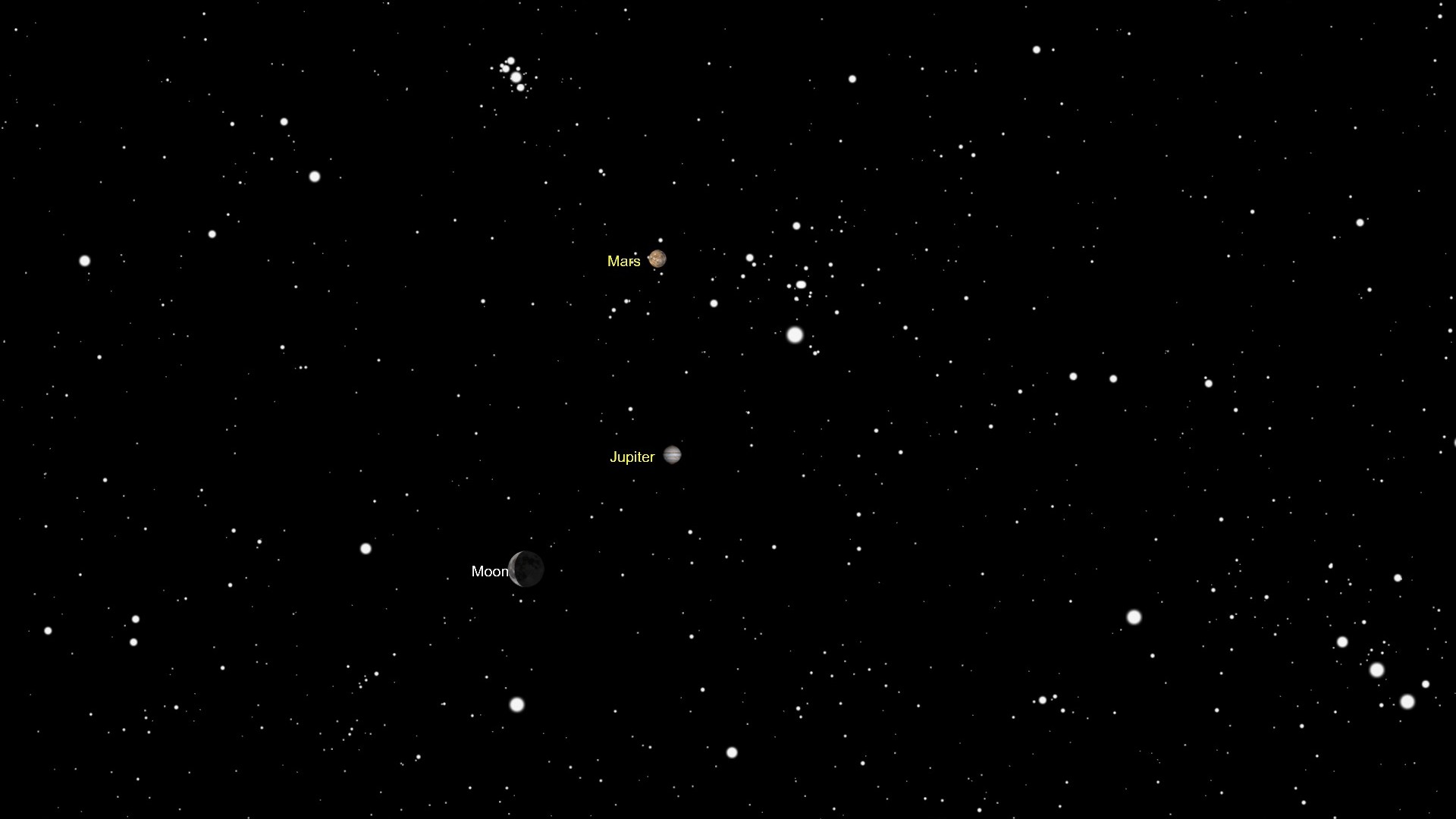
It is sometimes difficult to rouse one's self out of bed in the predawn hours to get a view of some celestial event. But it will be worth setting your alarm clock for 4 a.m. local daylight time on Wednesday morning (July 31) in order to get a view of two planets that will be engaged in an interesting tableau with a slender crescent moon.
The planets in question are Mars and Jupiter and they are like two ships passing in the midsummer night — or more precisely, passing on the edge of the late July dawn. At the break of dawn, you will find them about one-third more of the way up from the eastern horizon and separated by a wide 7 and a half degrees.
Although it is the lower of two, appearing below Mars, Jupiter is much brighter — almost 16 times brighter to be exact — with Jupiter staying in view long after the morning twilight has brightened enough to render its dimmer planet companion invisible.
And take a good long look and put this in your mental file, because things are going to change quite a bit between now and this summer. While Jupiter is the dominant planet now, keep in mind that with each passing day, Mars is getting closer to Earth.
On Wednesday it will be 149.1 million miles (239.9 million km) from Earth, but by the second week of January 2025 it will be two and a half times closer and will apparent virtually a match to Sirius, the brightest star in the sky — a far cry from its status now!
The moon pays a visit

Want to see the moon or the planets of the solar system in the night sky? We recommend the Celestron Astro Fi 102 as the top pick in our best beginner's telescope guide.
And there will be another member of the solar system that will pay these two worlds a visit on this Wednesday morning: A lovely waning crescent moon will form an obtuse triangle with Mars and Jupiter.
The trio will clear the east-northeast horizon soon after 2 a.m. local daylight time and will be well-placed for viewing a couple of hours later.
Get the Space.com Newsletter
Breaking space news, the latest updates on rocket launches, skywatching events and more!
And a few stars thrown in for good measure
Incidentally, don't get confused by another object that will be shining to the right of Jupiter with a very similar orange color and brightness to Mars. That will not be a planet, but a star, Aldebaran, marking the angry right eye of Taurus the Bull. Aldebaran marks the top of one side of a striking V-shaped pattern of dimmer stars, known as the Hyades star cluster.
Actually, Aldebaran is not part of the cluster at all, being situated about 65 light-years away, while the cluster itself is located about 100 lights farther out in space. But by sheer coincidence, both Aldebaran and the Hyades cluster are aligned to form a near perfect letter V, making up the face of the Bull.
And if you look about 18 degrees above the moon, you'll see the even more beautiful and unmistakable Pleiades star cluster, which at first glance appears like a tiny silver cloud, but if you look more carefully, you'll be able to distinguish six individual starlets.
Should you have binoculars, you'll get an even better view, not just of these stars, but of the moon and planets as well. So, if your local weather forecast calls for clear skies on Wednesday morning, try to get up and check this unusual planet rendezvous out. As we noted at the onset, all you have to do, is set the alarm clock for around 4 a.m.
And get up.
Remember: If you want to get a closer look at the moon or planets of the night sky, be sure to take a look at our guides to the best telescopes and best binoculars.
And if you want to photograph events like these, we have tips for how to photograph the moon and how to photograph the planets, as well as guides to the best cameras for astrophotography and best lenses for astrophotography.
Joe Rao serves as an instructor and guest lecturer at New York's Hayden Planetarium. He writes about astronomy for Natural History magazine, the Farmers' Almanac and other publications.
Join our Space Forums to keep talking space on the latest missions, night sky and more! And if you have a news tip, correction or comment, let us know at: community@space.com.

Joe Rao is Space.com's skywatching columnist, as well as a veteran meteorologist and eclipse chaser who also serves as an instructor and guest lecturer at New York's Hayden Planetarium. He writes about astronomy for Natural History magazine, Sky & Telescope and other publications. Joe is an 8-time Emmy-nominated meteorologist who served the Putnam Valley region of New York for over 21 years. You can find him on Twitter and YouTube tracking lunar and solar eclipses, meteor showers and more. To find out Joe's latest project, visit him on Twitter.









